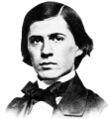Template:Selected anniversaries/April 19: Difference between revisions
No edit summary |
No edit summary |
||
| Line 1: | Line 1: | ||
<gallery> | <gallery> | ||
||Gustav Theodor Fechner (b. 19 April 1801), was a German philosopher, physicist and experimental psychologist. An early pioneer in experimental psychology and founder of psychophysics, he inspired many 20th century scientists and philosophers. He is also credited with demonstrating the non-linear relationship between psychological sensation and the physical intensity of a stimulus via the formula: {\displaystyle S=K\ln I} {\displaystyle S=K\ln I}, which became known as the Weber–Fechner law. Pic. | ||Gustav Theodor Fechner (b. 19 April 1801), was a German philosopher, physicist and experimental psychologist. An early pioneer in experimental psychology and founder of psychophysics, he inspired many 20th century scientists and philosophers. He is also credited with demonstrating the non-linear relationship between psychological sensation and the physical intensity of a stimulus via the formula: {\displaystyle S=K\ln I} {\displaystyle S=K\ln I}, which became known as the Weber–Fechner law. Pic. | ||
| Line 15: | Line 13: | ||
||1860 – On his phonautograph machine, Édouard-Léon Scott de Martinville makes the oldest known recording of an audible human voice. | ||1860 – On his phonautograph machine, Édouard-Léon Scott de Martinville makes the oldest known recording of an audible human voice. | ||
||1881: | File:Karl Mikhailovich Peterson.jpg|link=Karl Mikhailovich Peterson (nonfiction)|1881: Mathematician [[Karl Mikhailovich Peterson (nonfiction)|Karl Mikhailovich Peterson]] dies. He discovered equations now known as the Gauss–Codazzi equations, fundamental to the theory of embedded hypersurfaces in a Euclidean space. | ||
||Richard Edler von Mises (b. 19 April 1883) was a scientist and mathematician who worked on solid mechanics, fluid mechanics, aerodynamics, aeronautics, statistics and probability theory. | ||Richard Edler von Mises (b. 19 April 1883) was a scientist and mathematician who worked on solid mechanics, fluid mechanics, aerodynamics, aeronautics, statistics and probability theory. | ||
Revision as of 21:00, 18 April 2018
1881: Mathematician Karl Mikhailovich Peterson dies. He discovered equations now known as the Gauss–Codazzi equations, fundamental to the theory of embedded hypersurfaces in a Euclidean space.
1912: Chemist Glenn T. Seaborg born. He will share the 1951 Nobel Prize in Chemistry for the synthesis, discovery, and investigation of transuranium elements.
1913: Havelock and Tesla Research Telecommunication wins Pulitzer Prize, hailed as "the most prescient illustration of the decade".
1914: Mathematician and philosopher Charles Sanders Peirce dies. He is remembered as "the father of pragmatism".
2016: Theoretical physicist, theoretical chemist, and Nobel laureate Walter Kohn dies. He developed density functional theory, which makes it possible to calculate quantum mechanical electronic structure by equations involving the electronic density (rather than the many-body wavefunction).
2017: Steganographic analysis of Shell unexpectedly reveals "at least four-thousand and ninety six kilobytes" of encrypted data.





